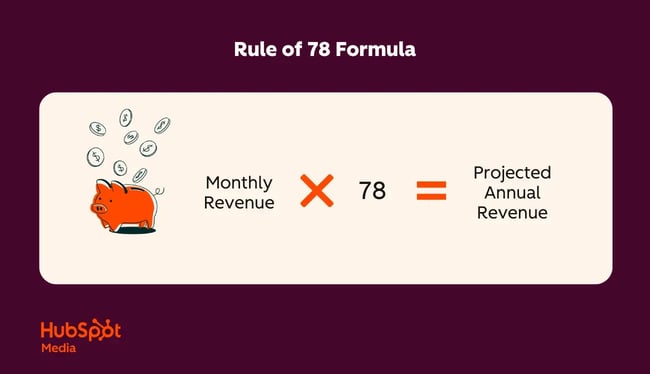That’s when someone introduced me to the Rule of 78.
It wasn’t just a formula; it was a mindset shift. Instead of thinking in terms of one-time sales, I started thinking in layers. Each month’s win is stacked on top of the last. Suddenly, the path to a million-dollar target was a staircase instead of a straight line.
If you’re in SaaS, professional services, or any business that runs on monthly recurring revenue (MRR), the Rule of 78 is one of the fastest ways to set realistic sales quotas. In this post, I’ll break down what the Rule of 78 is, how it works, and why it’s still one of the smartest shortcuts I’ve used to plan, forecast, and drive momentum in B2B sales.
Let’s unpack it.
Table of Contents
What is the rule of 78?
The Rule of 78 is a simple but powerful formula used to estimate annual revenue in businesses that operate on monthly recurring revenue (MRR). It’s especially useful for SaaS companies, subscription services, and other models where each new sale compounds month after month.

Here’s how it works: If you close a new deal in January, that revenue repeats 12 times. If you close one in February, it repeats 11 times. March? 10.
Add all those months up, 12 + 11 + 10 ... down to 1, and you get 78. Multiply your average monthly contract value by 78, and you’ve got your estimated annual revenue, assuming you sign one net-new customer each month at a fixed price.
But here’s the thing most sales leaders miss: The Rule of 78 isn’t just a calculator. It’s a mindset. I first learned it years ago while working with a startup that was struggling to forecast sales in a predictable way. We had deals trickling in inconsistently, and our end-of-year revenue always seemed like a guessing game.
Once we applied the Rule of 78, everything changed. We stopped chasing arbitrary monthly targets and started thinking in terms of cumulative value. That shift helped us ramp smarter, build quota plans aligned with runway, and coach reps to win earlier in the year when each sale had a greater compounding effect.
If you’re selling recurring revenue products and still calculating goals linearly, you’re probably underestimating the real cost of delay and the upside of momentum. The Rule of 78 gives you the clarity to plan, the urgency to act early, and the numbers to back up your decisions.
Rule of 78 Calculation for Sales Quotas
Understanding the Rule of 78 isn’t just a math exercise. It’s a lens that reshaped the way I think about sales momentum and quota setting.
Let’s unpack it.
At its core, the Rule of 78 helps you estimate total revenue from recurring monthly sales. If you add one new customer each month, each paying the same monthly fee, your total annual revenue isn’t 12 times the fee; it’s 78 times the monthly fee. That’s because each new customer contributes for fewer months the later they come in the year.
As mentioned above, January customers bring 12 payments, February brings 11, March brings 10, and so on. When you add them all up, 12 + 11 + 10 … + 1, you get 78. Hence, the name.
Now let’s flip the script and apply that same logic to sales quotas.
Most companies I’ve worked with (especially early-stage SaaS startups) make one critical mistake: They treat quota as a flat number. They’ll say, “Let’s hit $60K this year,” and then assign each rep a $5K/month target. Sounds fair, but here’s the problem. That assumes every deal, regardless of timing, has the same weight. And it doesn’t.
A deal closed in January adds 12 months of revenue. One closed in December adds just one. So if you wait too long to ramp your team, or if your reps don’t start strong, you fall behind fast.
When I was helping a team build out their sales plan during a new product launch, we used the Rule of 78 to reverse-engineer quota expectations. We weren’t just trying to hit an arbitrary number; we were trying to maximize early-year momentum. Every week we delayed, the ramp-up was money left on the table. And once reps understood the compounding impact of closing early, their urgency skyrocketed.
Here’s how we did the math:
- Let’s say your goal is $780,000 in new ARR by the end of the year. Divide that by 78, and you get $10,000 in monthly new revenue needed. That becomes your baseline.
- If you have five AEs, each rep is responsible for $2,000/month in net-new recurring revenue.
But here’s the twist: We front-loaded activity and incentives in Q1, because we knew that those early deals would pay off all year long.
The Rule of 78 isn’t perfect. It assumes zero churn and equal deal size, but it gives you a clear roadmap for setting smart quotas that align with how recurring revenue really works.
When sales leaders ignore this, they often miss their targets despite hitting their monthly goals. When they embrace it, they build quota plans that reward early performance, minimize surprises, and align every rep around long-term growth.
In a world obsessed with quarterly KPIs, the Rule of 78 reminds us that what you do in January echoes all year long.
Rule of 78 Example
A few years ago, I worked with a SaaS startup that wanted to scale their recurring revenue fast. They had a $500/month product and ambitious goals: $468,000 in new ARR.
But they were missing something critical: timing.
I showed them the Rule of 78.
Instead of just dividing $468K by $500 and calling it a day, we used the real math behind recurring revenue. I explained it like this, “If you close a deal in January, you earn that $500 12 times over the year. But if you wait until December? You only get it once.”
It clicked.
We walked through the logic visually:
- January = 12 months of revenue
- February = 11
- March = 10
- December = 1
Stack it all up? That’s 78 months of revenue in a single year, assuming just one new deal per month. Multiply your monthly quota by 78 and you get your annual forecast.
The Rule of 78 reframes how founders, sales leaders, and even investors think about growth. It’s not just about how much you sell. It’s when you sell it — and how quickly you can ramp.
This small formula changed how they hired, how they built a pipeline, and how they forecasted revenue. And it gave reps a clear reason to push hard in Q1, not coast into Q2.
Why I Still Use the Rule of 78
I’ve worked in sales long enough to know that revenue doesn’t magically show up at the end of Q4. It’s built in the early months, one consistent motion at a time. That’s why the Rule of 78 is still part of my mental toolkit, not because it’s perfect, but because it forces urgency, discipline, and clarity.
I use this rule when I’m building pipeline forecasts, onboarding new reps, or advising early-stage founders. It’s not just math. It’s momentum. It shows you how much your start matters and why front-loading your activity pays off in compound returns.
I’ve seen teams transform their sales planning just by running this formula. Suddenly, they understand that January isn’t just a fresh start, it’s the biggest multiplier of the year. That mindset shift alone can unlock stronger quota-setting, better hiring timelines, and more predictable revenue across the board.
The Rule of 78 won’t solve every problem. But in the world of recurring revenue, it gives you a reliable lens to zoom out, plan smart, and act early.
If you’re serious about quota design and revenue clarity, don’t just chase numbers. Use the Rule of 78 to guide the way you build them.
Editor's note: This post was originally published in January 2015 and has been updated for comprehensiveness.
Sales Quotas
.png?width=112&height=112&name=Image%20Hackathon%20%E2%80%93%20Square%20(14).png)

.png)